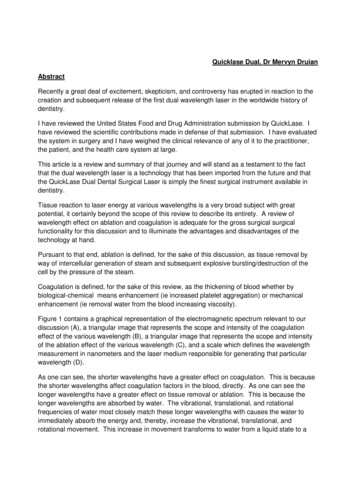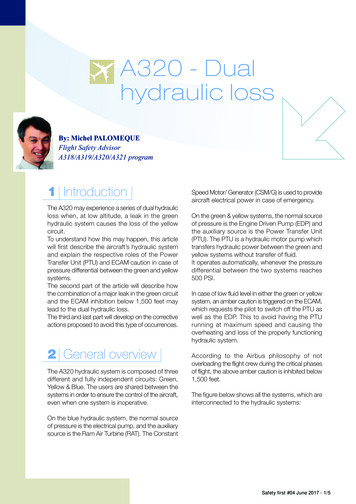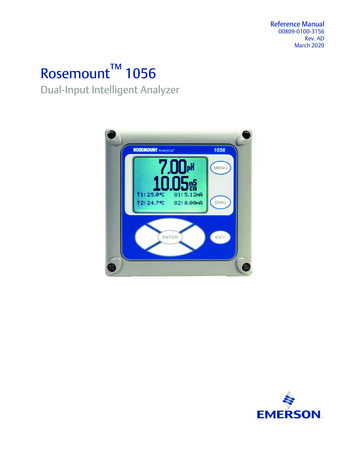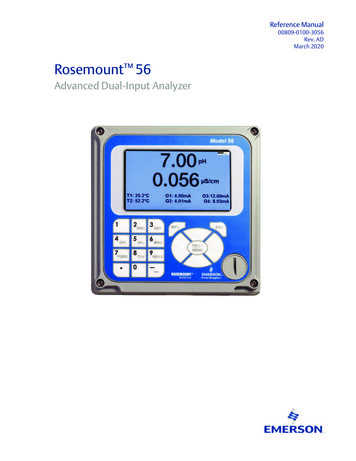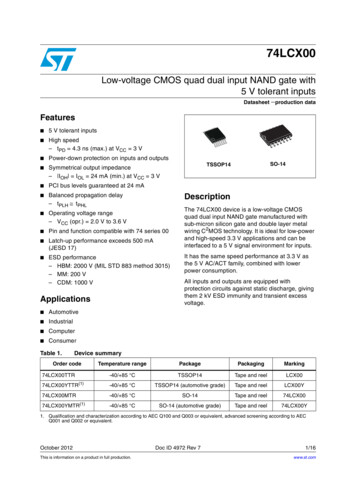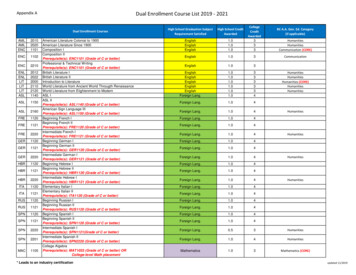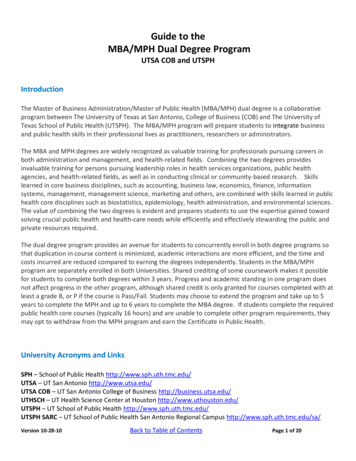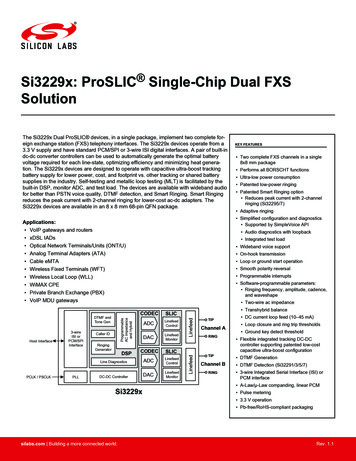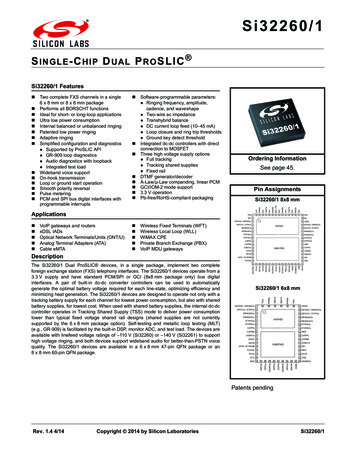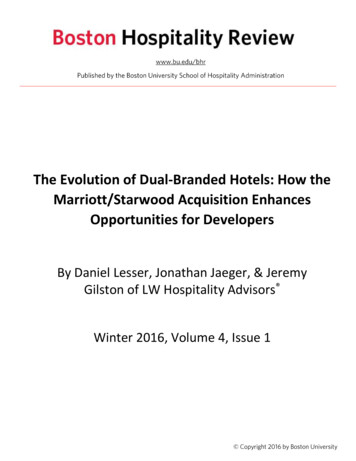
Transcription
The Evolution of Dual-Branded Hotels: How theMarriott/Starwood Acquisition EnhancesOpportunities for DevelopersBy Daniel Lesser, Jonathan Jaeger, & JeremyGilston of LW Hospitality Advisors Winter 2016, Volume 4, Issue 1
1 Behind Los Angeles' Staples Center sits the dual-branded JW Marriott and towering Ritz-Carlton (Photo by Prayitno)By Daniel Lesser,Jonathan Jaeger, & Jeremy Gilston of LW Hospitality Advisors Should the deal ultimately close, the recently announced acquisition of Starwood Hotels andResorts Worldwide, Inc. (HOT) by Marriott International (MI) will be a lodging industry gamechanger. MI is a trailblazer of the dual-branded hotel trend and will be well poised to acceleratethis concept by capitalizing on its newly-expanded suite of brands.While Starwood Preferred Guest (SPG) members are fixated on the future value of theirrewards points, Wall Street is focused on how the combined entities will maximize shareholdervalue, with many questions left unanswered. Post-acquisition, MI will include approximately 31brands, 5,500 hotels and 1.1 million rooms worldwide giving MI significant opportunity tocreate new dual-branding properties and concepts.pg. 1
Dual-branded hotels are not a new idea; however, the trend is gaining traction. Recent trendsreflect a shift towards greater sophistication in tailoring guest experiences and targetingspecific demand segments, thereby creating less overhead and greater cost efficiency. Theconcept has become increasingly popular as these developments include two hotels, and insome cases even more, that share construction/conversion costs and operational expenses,resulting in attractive development savings as well as an enhanced opportunity to achieveeconomic feasibility of a proposed project.During the past several years, the dual-branded hotel trend has accelerated. As of January2015, there were 79 operational dual-branded hotels and another 54 under construction in theU.S., a projected 32 percent increase in dual-branded supply (see chart below). MI, one of thetwo dominant dual-branding players (the other being Hilton Worldwide) is leading the way withboth the most existing and under-construction dual-branded hotels.2 Pairing JW Marriott and Fairfield Inn & Suites hotel in Downtown Indianapolis gives MI a strong local market share. (Photo byMr. Nixter)When contemplating a dual-branded development strategy, it is critical to maintain brandintegrity while selecting a project that fits in with the local market environment. While MI’smost popular pairing consists of the Residence Inn and Courtyard by Marriott brands, otherpairings exist, such as the JW Marriott and Fairfield Inn & Suites hotel in DowntownIndianapolis. The consortium of MI and HOT will undoubtedly enhance MI’s opportunities,combining many new brands and hotel product types, ultimately resulting in greater share inselect markets around the country.pg. 2
By way of example, Denver is one of the top 25 U.S. hotel markets and is currently experiencinga boom in dual-branded hotel development. Downtown Denver’s appeal as a business,convention, and leisure travel destination continues to entice developers. White Lodging, anIndiana-based hotel developer and operator, completed both the 17-story Convention CenterEmbassy Suites hotel in December 2010 and 21-story dual-branded Hyatt Place/Hyatt House at14th Street and Glenarm in Downtown Denver in November 2015.3 Not far from the dual-branded Hyatt House/Place on Denver's 14th Street sits the 17-story Convention Center Embassy Suiteshotel. Both properties were developed by Indiana-based firmed, White Lodging. (Photo by MomentsForZen).The company has since broken ground on a new dual-branded hotel development, the AC byMarriott and Le Méridien Hotel, HOT affiliated. The 18-story development is scheduled to openlate summer 2017 and the two hotels will add 495 rooms to the market. The property will belocated at the center of the city's business district proximate to multiple demand generators,including the Colorado Convention Center, the 16th Street Entertainment District, the ColoradoState Capital Complex, the LoDo Historic District, the Denver Performing Arts Complex, PepsiCenter, Coors Field and Sports Authority Field at Mile High. Each hotel will have its own distinctpg. 3
entry, lobby, and bar-led food and beverage outlet(s). Le Méridien will include /-8,000 squarefeet of state-of-the-art banquet and meeting space, including a 5,000-square-foot ballroom.The majority of newly-developed and under-construction dual-branded hotel developmentsoffer value enhancement opportunities by cost-efficiently developing new products withindense urban markets. However, many successful dual-branded hotels exist in airport markets aswell as suburban markets where supply is limited or demand is strong, such as the HomewoodSuites and Hampton Inn by Hilton located in Syracuse/Liverpool, New York.Dual-branded hotels eliminate the expense of constructing separate towers for each brandwhile allowing for shared amenities such as fitness centers, pools, and meeting rooms as well asback-of-house spaces including kitchens, storage, and mechanical areas. In reference to a 2013dual-branded hotel development in Atlanta, Georgia, it was reported that the developer, NorthPoint Hospitality Group, saved 15,000 to 25,000 per key on construction costs when it built a228-room Hilton Garden Inn and Homewood Suites hotel. While separate signage, entrances,and lobbies create distinct brand identities within a single structure, only one design andconstruction program for back of the house and building systems are needed.Furthermore, from an operational perspective, efficiencies are created through utilization ofshared staff, specifically as it relates to management, sales & marketing, and maintenance.Brand selection processes are largely dependent on a sub-market’s existing and forecastedsupply and demand trends. As the economic feasibility of new hotel developments isdetermined for a market, factors to consider pertaining to the selection of optimal hotel brandsinclude name recognition and perception, global footprint, frequent guest programs, andlicense fees.Subsequent to the acquisition, MI will be well positioned to leverage the strengths of bothbrand families as illustrated below:4 Source: Marriott International Investor Relations. 08 Dec. 2015. Web. 07 Jan. 2016.pg. 4
MI’s historically strong sales platform and successful owner/investor relationships, coupledwith HOT’s sizeable international presence and customer relationship management, will createunparalleled synergies.According to the MI investor relations website, the majority of MI’s development pipeline islocated in the United States. As of Q3 2015, HOT, with a strong international footprint, hasroughly a quarter of its room inventory situated in Asia, approximately double the roominventory of MI. The combination of MI and HOT will undoubtedly create significant potentialfor dual-branded hotel development throughout the world as they capitalize on strengths whilelessening weaknesses.To remain relevant and efficient, competitive brand families will need to create and exploittheir own dual-branding opportunities. Continued consolidation is likely as hotel companiesattempt to achieve operating efficiencies. The MI acquisition of HOT may very well mark thebeginning of a wave of hotel mergers and acquisitions. Most recently, Accor, Europe’s largesthotel operator, announced its intent to acquire three iconic brands, namely Fairmont, Rafflesand Swissotel brands through its parent company FRHI.Dual-branded hotels have become a focus of the hotel industry over the last several years. Withnews of the MI acquisition of HOT, the next generation of dual-branded hotels will surely beenhanced. In today’s competitive environment, developers are constantly looking for new waysto differentiate their product. Future mergers and acquisitions as well as creative hoteldevelopers will continue to evolve and expand the dual-branded hotel concept.Daniel H. Lesser has more than 30 years of expertise in a wide range ofhospitality operational, investment counseling, valuation, advisory, andtransactional services. He currently serves as the President and CEO of LWHospitality Advisors , based in New York City.Mr. Lesser is a leading authority on hotel feasibility and valuation, and ishighly sought after to speak at lodging and real estate events, as well aslectures at prestigious institutions of higher education, including CornellUniversity, Columbia University and New York University. He is widely published and quoted,and serves as a quarterly columnist for HotelNewsNow.com and GlobeSt.com.Most recently, Mr. Lesser created and served as the Senior Managing Director-Industry Leaderof the Hospitality & Gaming Valuation Advisory Services Group at CB Richard Ellis Hotels (CBRE).Prior to joining CBRE, Mr. Lesser founded and led the Hospitality & Gaming Group at Cushman& Wakefield and was a founding member of the team at HVS International. Mr. Lesser has alsoheld operational and administrative positions with Hilton Hotels Corporation and EurotelsSwitzerland.He earned a Bachelor of Science degree in Hotel Administration from Cornell University, andalso attended the Ecole hôtelière de Lausanne, Switzerland and Baruch College- City Universityof New York. Mr. Lesser holds the following professional designations: MAI (Member of thepg. 5
Appraisal Institute), FRICS (Fellow of The Royal Institution of Chartered Surveyors), CRE(Counselor of Real Estate), and CHA (Certified Hotel Administrator).Jonathan Jaeger currently serves as a Managing Director with LWHospitality Advisors , based in New York City. Prior to joining LWHA , Mr.Jaeger had been with Pinnacle Advisory Group from January of 2008through January of 2014. He began as a Consultant in the Boston office andwas promoted to Vice President and head of the New York Practice. Duringhis tenure, Mr. Jaeger was involved in the execution of over 300 consultingand valuation assignments throughout the United States.Prior to his advisory career, Mr. Jaeger held various operational and accounting/financepositions with Starwood Hotels & Resorts and Kimpton Hotels & Resorts. He graduated with aBachelor of Science from the Boston University School of Hospitality Administration in additionto a minor in Business Administration from the Boston University School of Management. Mr.Jaeger is a State Certified Real Estate Appraiser specializing exclusively in the evaluation ofhotel properties. During his time in Boston, he served on the Emerging Leaders Committee ofthe Massachusetts Chapter of the Appraisal Institute as well as a Council Member of theMassachusetts Lodging Association Under 30 Gateway Chapter. Beginning in the spring of 2011,Mr. Jaeger joined the adjunct faculty at Boston University, serving as co-instructor of the HotelAsset Management course. In addition to teaching a course at Boston University, Mr. Jaeger haswritten several articles for industry wide publications; topics included the Manhattan LodgingMarket, Highest and Best Use Analyses, E-Commerce in the Hotel Industry, among others. InNew York City, Jonathan is a member of YHIP, the Young Hospitality Investment ProfessionalsGroup and also participates with the NYC & Company Hotel Committee in addition to recentlyaffiliating with the Metro NY Chapter of the Appraisal Institute.Mr. Jaeger is a designated member of the Appraisal Institute (MAI); he achieved thisdesignation in June of 2013. In addition, Mr. Jaeger is an active member of the American Hotel& Lodging Association (AH&LA) as well as a Development Coach for the United StatesProfessional Tennis Association (USPTA).pg. 6
two dominant dual-branding players (the other being Hilton Worldwide) is leading the way with both the most existing and under-construction dual-branded hotels. 2 Pairing JW Marriott and Fairfield Inn & Suites hotel in Downtown Indianapolis gives MI a strong local market share. (Photo by Mr. Nixter)File Size: 652KB

